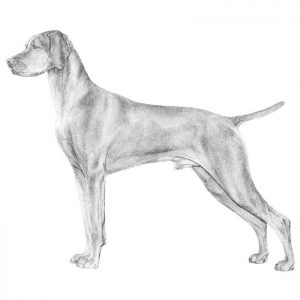Gentle, affectionate, energetic
 GENERAL APPEARANCE
That of a medium-sized, short-coated, hunting dog of distinguished appearance and bearing. Robust but rather lightly built, the coat is an attractive shaded golden rust. Originating in Hungary, the Vizsla was bred to work in field, forest and water. Agile and energetic, this is a versatile dog of power, drive and endurance in the field yet a tractable and affectionate companion in the home. It is strongly emphasized that field conditioned coats, as well as brawny or sinewy muscular condition and honorable scars indicating a working and hunting dog are never to be penalized in this dog. The requisite instincts and abilities to maintain a “dual dog” are always to be fostered and appreciated, never deprecated.
HEAD
Lean and muscular. SA partially or completely black nose is a disqualification. Freckles due to aging or sun exposure are not to be faulted. Ears, thin, silky and proportionately long, with rounded-leather ends, set fairly low and hanging close to cheeks. Jaws are strong with well developed white teeth meeting in a scissors bite. Eyes medium in size and depth of setting, their surrounding tissue covering the whites. Color of the iris should blend with the color of the coat. Yellow or any other color is faulty. Prominent pop eyes are faulty. Lower eyelids should neither turn in nor out since both conditions allow seeds and dust to irritate the eye. Lips cover the jaws completely but are neither loose nor pendulous.
BODY
Neck strong, smooth and muscular, moderately long, arched and devoid of dewlap, broadening nicely into shoulders which are moderately laid back. This is mandatory to maintain balance with the moderately angulated hindquarters. Body is strong and well proportioned. Withers high. While the Vizsla may appear square, when measured from point of breastbone to point of buttocks and from the highest point over the shoulder blades to the ground, the Vizsla is slightly longer than tall. A proper proportion of leg length to body length is essential to the desired overall balance of the Vizsla. The Vizsla should not appear long and low or tall and leggy.
COAT
Short, smooth, dense and close-lying, without woolly undercoat. A distinctly long coat is a disqualification.
FOREQUARTERS
Shoulder blades proportionately long and wide sloping moderately back and fairly close at the top. Upper arm is about equal in length to the shoulder blade in order to allow for good extension. Forelegs straight and muscular with elbows close. Feet cat-like, round and compact with toes close.
HINDQUARTERS
Hind legs have well developed thighs with moderately angulated stifles and hocks in balance with the moderately laid back shoulders. They must be straight as viewed from behind. Too much angulation at the hocks is as faulty as too little. The hocks are let down and parallel to each other.
GENERAL APPEARANCE
That of a medium-sized, short-coated, hunting dog of distinguished appearance and bearing. Robust but rather lightly built, the coat is an attractive shaded golden rust. Originating in Hungary, the Vizsla was bred to work in field, forest and water. Agile and energetic, this is a versatile dog of power, drive and endurance in the field yet a tractable and affectionate companion in the home. It is strongly emphasized that field conditioned coats, as well as brawny or sinewy muscular condition and honorable scars indicating a working and hunting dog are never to be penalized in this dog. The requisite instincts and abilities to maintain a “dual dog” are always to be fostered and appreciated, never deprecated.
HEAD
Lean and muscular. SA partially or completely black nose is a disqualification. Freckles due to aging or sun exposure are not to be faulted. Ears, thin, silky and proportionately long, with rounded-leather ends, set fairly low and hanging close to cheeks. Jaws are strong with well developed white teeth meeting in a scissors bite. Eyes medium in size and depth of setting, their surrounding tissue covering the whites. Color of the iris should blend with the color of the coat. Yellow or any other color is faulty. Prominent pop eyes are faulty. Lower eyelids should neither turn in nor out since both conditions allow seeds and dust to irritate the eye. Lips cover the jaws completely but are neither loose nor pendulous.
BODY
Neck strong, smooth and muscular, moderately long, arched and devoid of dewlap, broadening nicely into shoulders which are moderately laid back. This is mandatory to maintain balance with the moderately angulated hindquarters. Body is strong and well proportioned. Withers high. While the Vizsla may appear square, when measured from point of breastbone to point of buttocks and from the highest point over the shoulder blades to the ground, the Vizsla is slightly longer than tall. A proper proportion of leg length to body length is essential to the desired overall balance of the Vizsla. The Vizsla should not appear long and low or tall and leggy.
COAT
Short, smooth, dense and close-lying, without woolly undercoat. A distinctly long coat is a disqualification.
FOREQUARTERS
Shoulder blades proportionately long and wide sloping moderately back and fairly close at the top. Upper arm is about equal in length to the shoulder blade in order to allow for good extension. Forelegs straight and muscular with elbows close. Feet cat-like, round and compact with toes close.
HINDQUARTERS
Hind legs have well developed thighs with moderately angulated stifles and hocks in balance with the moderately laid back shoulders. They must be straight as viewed from behind. Too much angulation at the hocks is as faulty as too little. The hocks are let down and parallel to each other.

01].png)
01].png)